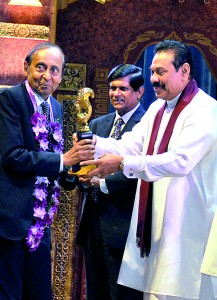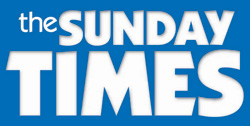The journey of Sinhala literary criticism
Criticism had not been an exciting segment in Sinhala literature till focus was drawn to it by Peradeniya critics. They understood the value of the study and criticism of Sinhala Literature and laid the foundation structured with firm links between literary education and literary criticism. This took place in the 1960s – the era hailed as the golden age of contemporary Sinhala literature.
The multitude of universities that have been set up since then should have continued the momentum and taken literary-education to higher levels. This has not happened.

Prof. Wimal Dissanayake receiving the Sahithyaratne award from President Rajapaksa at the State Literary Awards last month
Professor Wimal Dissanayake, eminent Lankan scholar who was invited by the State Literary Panel to deliver the ceremonial lecture which precedes the State Literary Awards, speaking on “Criticism of Sinhala Literature: its challenges and goals” said that even at Peradeniya, the birthplace of literary criticism, literary-activity has lost its lustre and there is a lull in literary activity. Peradeniya critics still live in the 1960s. When they discuss modern literary criticism, they have not advanced beyond I.A. Richards, F.R. Leavis or L.C. Knights.
Professor Dissanayake, an alumni of Peradeniya University in Sinhala, Sanskrit and English also specialized in Sinhala and obtained his doctorate in English Literature from Cambridge University. He has a string of academic qualifications from varied universities and has authored and edited over 30 books published by prestigious publishing houses. Currently, he is teaching at the Academy for Creative Media at the University of Hawaii.
Going back to this glittering age which nourished Professor Dissanayake’s intellectual quest he identified Ediriweera Sarachchandra – his guru and mentor not as a dramatist but as a literati and a critic. He credited Sarachchandra for making literary criticism a significant component in Sinhala literature. Sarachchandra had said “a person who knows only Sinhala does not know even Sinhala,” as he believed that to gain a proper knowledge of Sinhala literature, a comparative understanding and intellect were needed. Sarachchandra as such, introduced students to the works of classical authors such as Tolstoy and Dostoevsky as he understood the value of comparisons of varied perspectives when indulging in critical evaluations of literature.
The introduction even extended to eminent Western critics with Sarachchandra and the Peradeniya critics broadening the parameters of literary criticism. Students were shown common features that existed in criticism in the West and the literature of the East and the new interest created with the introduction of new theories saw words such as realism, credibility, uniformity, sensationalism…. invading the literary vocabulary. As significant towards the stimulated literary, activity, he said was the influence of the then professor of the English department, Professor E.F.C. Ludowyke.
However, Professor Dissanayake stated that the huge transformation that was taking place in the outside world was not seen impacting on the Peradeniya literary landscape. University critics were immune to these winds that were blowing and of the fact that there should have been a link between literature and the society. This paved the way for the birth of literary criticism under the concept of People’s Literature, the next step of the development of contemporary Sinhala literature and criticism.
What is the difference, he asked, between an intellectual and an academician? He said Martin Wickramasinghe, who had never stepped into a University and having not gone beyond the 8th standard in school, is the best example of an intellectual. Professor Dissanayake lists him as the best Sri Lankan critic along with Gunadasa Amarasekera and Sarachchandra. The Professor incidentally said that Martin Wickremasinghe in one of his criticisms charged that Sarachchandra undervalued Buddhism in his literary work.
Professor Dissanayake traced the history of contemporary Sinhala literary criticism to 8 decades. And besides the three critics already mentioned he said that Munidasa Kumaratunge, Venerable Kotahene Paggnakitthi, W.F. Gunawardene, G. B. Senanayake, K. Jayatilleke, Siri Gunasinghe, Ariya Rajakaruna, A.V. Suraweera and several others were the earliest scholars who engaged in literary criticism. “They had their own standards of estimation and forwarded varied critical views and theories,” he said. From the 1940s to the 1960s, these views were published in books, newspapers, journals and through radio discussions.
New directions to criticism however, were given at Peradeniya in the 1960s led by Sarachchandra. Initially, names of Martin Wickremasinghe, Gunadasa Amarasekera and Siri Gunasinghe too figured among the Peradeniya Critics’ Group. Later however, these three distanced themselves from the Peradeniya group and pointed out the shortcomings of Peradeniya criticism. Yet, the theories, concepts, values and views of Peradeniya literary criticism continued to spread through those who passed out from Peradeniya as teachers, writers, journalists et al.
By 1970s, fresh winds were blowing in Colombo with critics such as Gunasena Vitanage popularising the People’s Literary concept which focused on how literature could help to develop society. Many young poets were drawn to this concept with the People’s Writers’ Forum and “Mawatha” – an organisation formed by Susil Siriwardene attempting to give a life-line to it. As this lacked an academic base, this concept graduated to a mere slogan-literature in prose and verse. By the 1980s, literary criticism was seen drifting towards Marxism spearheaded by critics such as Sucharitha Gamlath. Once again, with Marxism being a living-theory, the writing and criticism could not keep pace with the Marxist style of literary criticism and the Marxist concepts too were seen falling by the wayside.
Professor Dissanayake however, hails Post Modernism which is seen attempting to broaden the horizon of Sinhala literature criticism with the influence of concepts such as “Maya Realism”. The complex interactions between the writer, the literary work, the reader and the settings are reflected in this concept through novel perspectives with a strident call to enhance the intellect of the reader.


